Washington State is a land of striking natural beauty, offering scenic drives that take travelers through lush rainforests, towering mountains, serene rivers, and rolling farmlands. Whether you’re cruising along coastal highways or navigating alpine passes, each route offers a unique experience across all four seasons.
In spring, wildflowers bloom and rivers swell with snowmelt; summer invites exploration of sparkling lakes and verdant forests; fall in Washington paints the landscape with brilliant hues of red and gold; and winter blankets the mountains and valleys with peaceful snow. From the temperate rainforests of the Olympic Peninsula to the rolling hills of the Palouse, this guide highlights the best drives across the state’s diverse regions, offering insider tips and must-see stops along the way. Check out these Road Trips in Oregon as well!
Western Washington Scenic Drives
Chuckanut Drive (Highway 11)
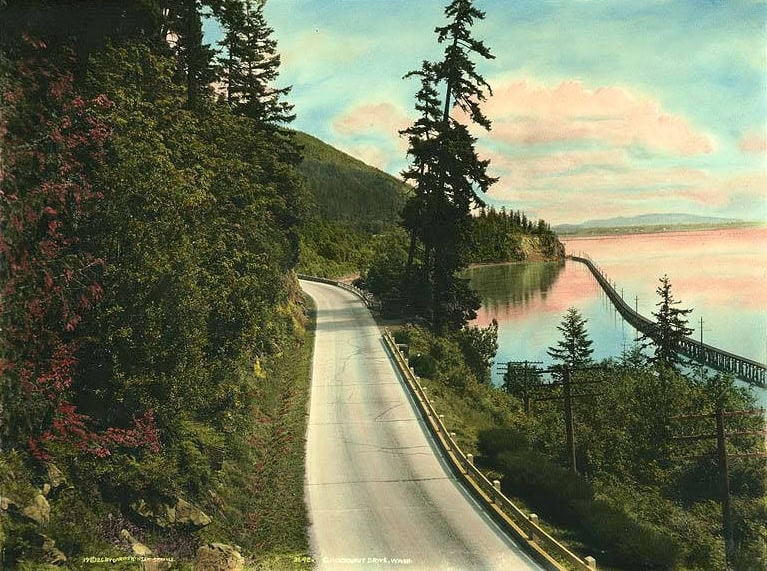
Route & Directions:
- Start in Burlington by taking Exit 231 off I-5. Follow Highway 11 south along the coast to Bellingham. This 24-mile scenic route hugs the cliffs of the Chuckanut Mountains and offers stunning views of the San Juan Islands.
Spring:
- Description: In spring, the drive is lined with blooming wildflowers and lush, green forest. The waterfalls along the cliffs are at their most powerful due to spring runoff.
- Stops:
- Larrabee State Park: Great for hiking, with trails leading to beaches and forests. Explore the tide pools at Clayton Beach.
- Taylor Shellfish Farms: Stop here to enjoy fresh oysters while sitting by the water.
- Tip: Rain is common in spring, so pack a waterproof jacket and be ready for cooler temperatures. Early mornings offer fewer crowds, making the hike to Fragrance Lake peaceful.
Summer:
- Description: Summer offers clear skies and ideal conditions for exploring the beaches and cliffs. The cool ocean breeze makes this drive a refreshing retreat.
- Stops:
- Samish Bay Overlook: Ideal for scenic photos of the bay and islands.
- Fairhaven Historic District: End your trip in Bellingham’s charming Fairhaven District, filled with shops, cafes, and local restaurants offering outdoor dining.
- Tip: Arrive early on weekends, as the drive can be busy. The outdoor dining in Fairhaven is perfect for enjoying the summer weather.
Fall:
- Description: The foliage along Chuckanut Drive bursts into vibrant hues of red, orange, and yellow, creating a stunning contrast with the blue waters of the Puget Sound.
- Stops:
- Blanchard Mountain: A perfect fall hike with views of the islands surrounded by autumn colors.
- Taylor Shellfish Farms: Autumn is a great time for shellfish. Stop in for a local seafood treat while enjoying the fall views.
- Tip: Fall weekdays are less crowded, and the crisp air makes hiking along the Chuckanut Ridge Trail comfortable.
Winter:
- Description: Winter offers peaceful, misty views along the coast. While the drive is less busy, it’s a serene way to enjoy the region without the crowds.
- Stops:
- Fairhaven: Warm up in cozy cafes or explore the local shops for unique holiday gifts.
- Larrabee State Park: If conditions allow, take a winter walk along the beach at low tide.
- Tip: Be cautious of icy spots on the road during colder days. Drive slowly to enjoy the coastal views shrouded in mist.
Olympic Peninsula Loop (Highway 101)
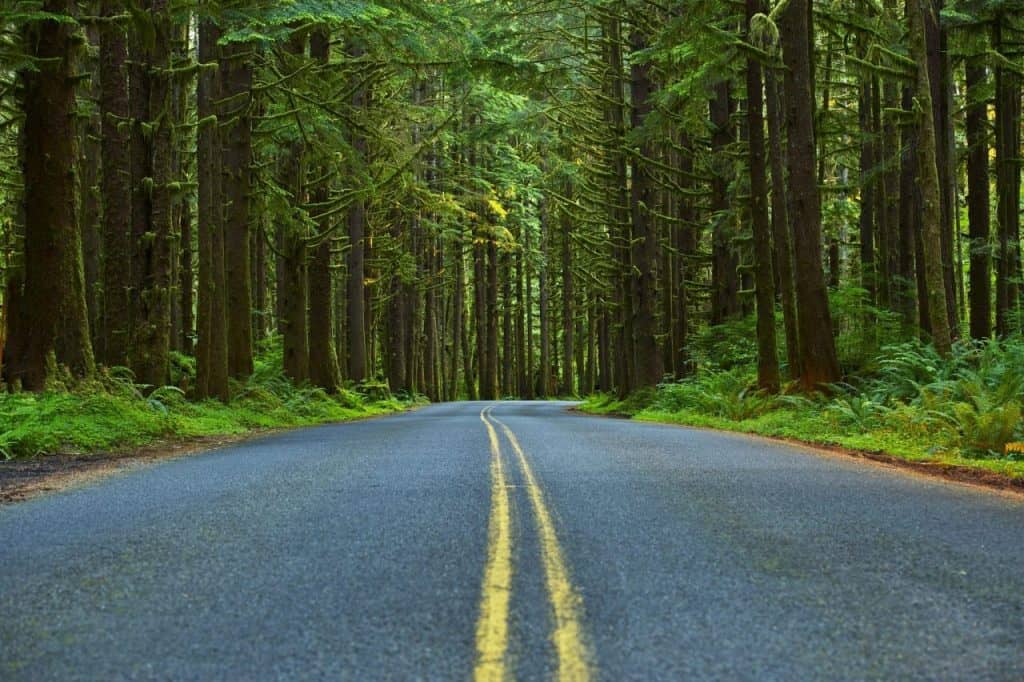
Route & Directions:
- Start in Port Angeles and follow Highway 101 west around the Olympic Peninsula. This loop covers over 300 miles, showcasing diverse landscapes, from rainforests to beaches and mountains.
Spring:
- Description: The rainforests are lush and vibrant in spring, with waterfalls roaring from snowmelt. Wildflowers dot the landscape, especially around Lake Crescent.
- Stops:
- Hoh Rainforest: Explore the Hall of Mosses Trail, where new growth covers the forest floor.
- Lake Crescent: Hike to Marymere Falls, which is at its most powerful during the spring melt.
- Tip: Rain is common in spring, so waterproof gear is essential. Enjoy quieter trails before the summer crowds arrive.
Summer:
- Description: Summer brings clear skies, perfect for exploring the coast and hiking in the mountains. Hurricane Ridge is a highlight with its alpine views and meadows filled with wildflowers.
- Stops:
- Ruby Beach: Explore tide pools and sea stacks along the rugged coast.
- Hurricane Ridge: Drive up to the ridge for panoramic views of the Olympic Mountains.
- Tip: Summer weekends can be crowded at popular spots like Hurricane Ridge. Visit early in the day for the best experience.
Fall:
- Description: Fall transforms the peninsula with golden foliage, especially around Sol Duc Hot Springs and Lake Crescent. Cooler temperatures make hiking more comfortable.
- Stops:
- Sol Duc Hot Springs: Take a dip in the hot springs surrounded by fall colors.
- Lake Crescent: The calm lake reflects the surrounding fall foliage, creating a perfect photo opportunity.
- Tip: Early fall is ideal for outdoor activities before the rainy season begins. Bring layers for cooler weather.
Winter:
- Description: Winter on the Olympic Peninsula offers quiet trails and storm-watching opportunities along the coast. The rainforests stay green year-round, providing a peaceful retreat.
- Stops:
- Kalaloch Lodge: A perfect spot to watch winter storms rolling in from the Pacific.
- Lake Quinault Lodge: Cozy up by the fire in this historic lodge after a peaceful winter walk.
- Tip: Some higher-elevation roads, like Hurricane Ridge, may close due to snow. Storm-watching is a winter highlight, especially from coastal lodges.
Hood Canal Scenic Byway (Highway 101)
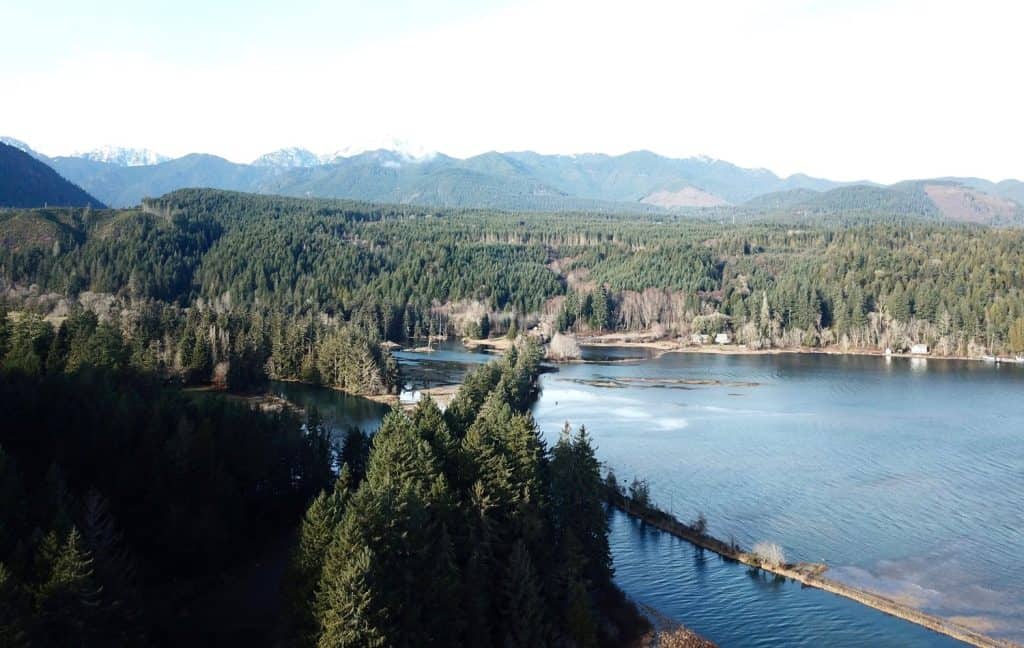
Route & Directions:
- Starting in Shelton, follow Highway 101 north along the shores of the Hood Canal, through towns like Hoodsport and Quilcene.
Spring:
- Description: Waterfalls are at their peak, and the forests surrounding Hood Canal are lush with new growth.
- Stops:
- Rocky Brook Falls: A short walk to this 240-foot waterfall is perfect in spring when the water is at its highest.
- Dosewallips State Park: Great for hiking, birdwatching, and wildlife viewing.
- Tip: Spring rains bring the waterfalls to life, so plan to visit them in the morning for the best light. Don’t forget your rain gear!
Summer:
- Description: Summer is ideal for exploring the Hood Canal’s beaches and oyster farms. The cool water makes it a refreshing escape from the heat.
- Stops:
- Hama Hama Oyster Saloon: Enjoy freshly shucked oysters right by the water.
- Kayaking: Rent a kayak in Hoodsport and explore the peaceful waters of the canal.
- Tip: Summer is the busiest season, so plan to visit popular spots like the oyster farms early in the day.
Fall:
- Description: Fall colors along the Hood Canal are spectacular, especially as the leaves turn golden and red. It’s also the perfect time for mushroom hunting and seafood.
- Stops:
- Dosewallips State Park: A great spot for fall foliage and fishing along the river.
- Hama Hama Oyster Saloon: The best time for fresh seafood, including oysters and clams.
- Tip: Fall is the start of oyster season, so enjoy the bounty at local farms and restaurants. Dress warmly for cool mornings and evenings.
Winter:
- Description: Winter along the Hood Canal offers peace and solitude. While some businesses may close, the natural beauty remains.
- Stops:
- Lilliwaup Falls: A quiet, scenic waterfall that’s especially striking in winter.
- Scenic driving: Enjoy the misty, atmospheric views of the canal and surrounding forests.
- Tip: Roads can be icy, so drive slowly and enjoy the serene winter landscape. Winter is great for storm-watching along the waterfront.
Mount Baker Highway
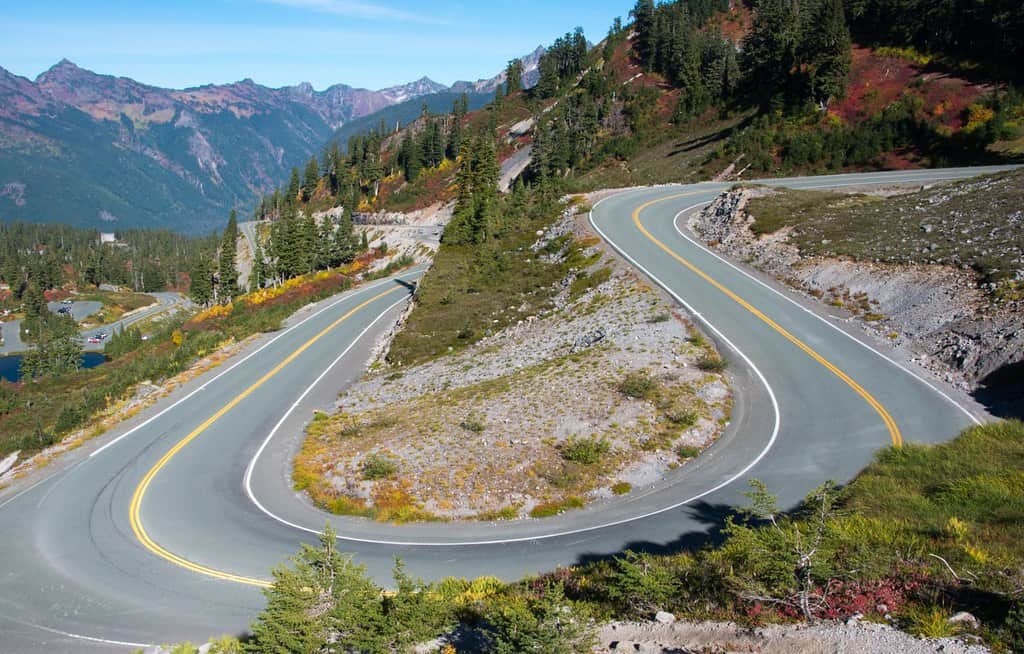
Route & Directions
- Start in Bellingham and follow State Route 542 east toward Mount Baker Ski Area. This 57-mile drive offers breathtaking views of Mount Baker and Mount Shuksan, passing through lush forests, alpine meadows, and river valleys.
Spring
- Description: The lower sections of the highway start to thaw, and wildflowers begin blooming. Snowmelt makes waterfalls along the route especially dramatic.
- Stops:
- Nooksack Falls: A short walk takes you to this waterfall, which is especially powerful in spring due to snowmelt.
- Picture Lake: Early blooms reflect in the lake, with the snow-capped Mount Shuksan in the background.
- Tip: Higher elevations may still have snow, so check road conditions before heading toward Artist Point, which may remain closed until summer.
Summer
- Description: The highway is fully open, with clear roads leading to Artist Point, one of the most scenic areas in the region. Alpine meadows are in full bloom, and views of Mount Baker are unparalleled.
- Stops:
- Heather Meadows: Hike through wildflower-filled meadows and enjoy views of the surrounding mountains.
- Artist Point: Drive to the end of the highway for panoramic views of Mount Baker and Mount Shuksan.
- Tip: Arrive early in summer, as Artist Point and trailheads get crowded. Bring sunscreen, water, and hiking gear.
Fall
- Description: Fall brings cooler temperatures and fewer crowds, with golden larches and autumn hues decorating the alpine landscape.
- Stops:
- Mount Baker Ski Area: The ski area is great for fall hiking, offering trails with views of the surrounding mountains.
- Chain Lakes Trail: A popular fall hike with stunning views of the mountains and lakes reflecting fall colors.
- Tip: Prepare for cooler temperatures and unpredictable weather. Check trail conditions before heading out, especially at higher elevations.
Winter
- Description: The highway remains open up to Mount Baker Ski Area, making it a great winter destination for snow sports and winter hiking.
- Stops:
- Mount Baker Ski Area: Skiing and snowboarding are popular in winter, with the area’s deep snowpack offering excellent conditions.
- Nooksack Falls: This waterfall looks magical in winter when surrounded by snow.
- Tip: Be prepared for snow-covered roads. Chains may be required, and always check weather forecasts before your trip.
Whidbey Island Scenic Byway
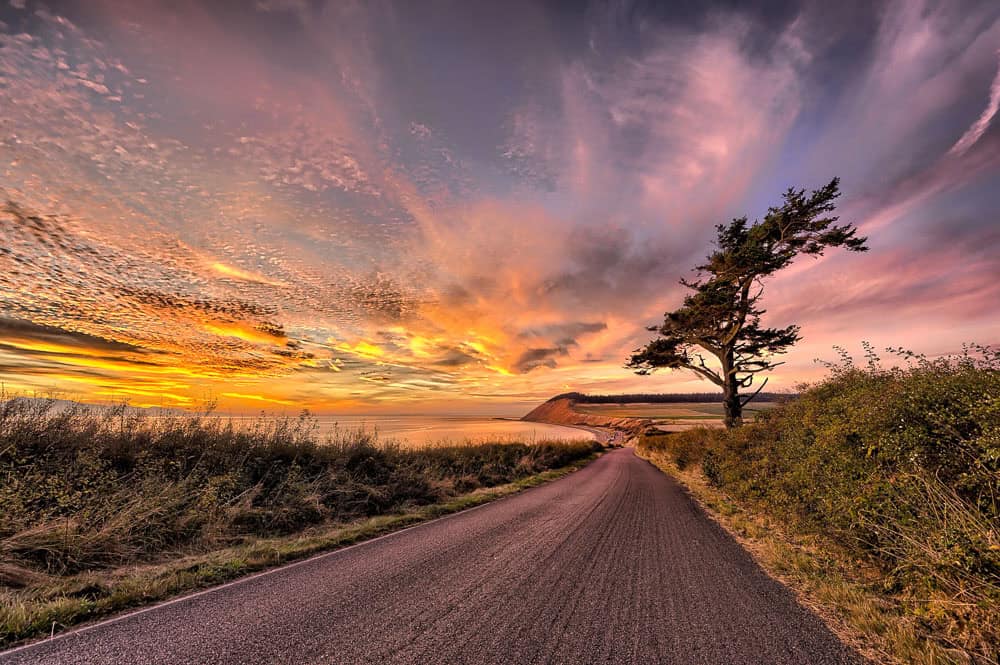
Route & Directions
- Begin your journey by taking the Mukilteo Ferry from Everett, then drive north along State Route 525 through Whidbey Island. This byway covers around 50 miles and includes some of the island’s most iconic landscapes.
Spring
- Description: Spring brings new growth and flowers to Whidbey Island. The island’s farmland and forests are vibrant with fresh greenery, and there’s plenty of wildlife to see.
- Stops:
- Ebey’s Landing National Historical Reserve: Hike the bluff trail for spectacular views of the Pacific Ocean and surrounding farmland.
- Deception Pass State Park: Visit this iconic park for views of the towering Deception Pass Bridge and its surrounding coastline.
- Tip: Take the ferry early in the morning to avoid long waits. Dress warmly as spring can still be cool and windy.
Summer
- Description: Summer is the busiest season on Whidbey Island, offering sunny weather and warm days. The beaches and parks are perfect for exploring.
- Stops:
- Fort Casey State Park: Explore the historic military fort and enjoy the ocean views. Perfect for picnics and beach walks.
- Langley: This charming town is known for its local boutiques, art galleries, and waterfront views. Grab lunch or shop for local crafts.
- Tip: Whidbey Island gets busy in summer, so plan ahead and book ferry reservations if possible. Bring a picnic and enjoy the coastal parks.
Fall
- Description: Fall brings cooler weather and fewer crowds, making it a peaceful time to explore the island’s forests and coastline. The changing leaves add color to the landscape.
- Stops:
- Greenbank Farm: Visit this farm for fall foliage and locally grown produce. Enjoy a walk through the farm’s fields and trails.
- Coupeville: One of Washington’s oldest towns, Coupeville offers historic charm, quiet streets, and views of Penn Cove.
- Tip: Fall is great for photography, with golden fields and autumn foliage around Ebey’s Landing and Deception Pass. Dress warmly for cooler days.
Winter
- Description: Winter on Whidbey Island is quiet and peaceful. It’s a great time for storm-watching along the coast or enjoying a cozy retreat.
- Stops:
- Deception Pass State Park: The dramatic coastline is even more striking during winter storms. Winter hiking is a great option, with trails often quieter than in summer.
- Langley: Visit the local shops and cafes for a warm drink after a day of exploring.
- Tip: Prepare for rainy, windy weather. Winter ferries are less crowded, making it easier to plan a spontaneous trip.
South-Central Scenic Drives in Washington
Mount Rainier Loop

Route & Directions
- Start in Enumclaw and follow State Route 410 east through Chinook Pass. The loop continues along State Route 123 and returns via the Nisqually Entrance to Mount Rainier National Park, making this a 147-mile scenic drive.
Spring
- Description: In spring, the lower areas of the park come to life as snow melts and wildflowers begin to bloom. Rivers and waterfalls are particularly strong this time of year.
- Stops:
- Tipsoo Lake: A stunning alpine lake just below Chinook Pass, offering early wildflower blooms.
- Grove of the Patriarchs: Walk among ancient, towering trees on this peaceful, family-friendly trail.
- Tip: The higher elevations may still have snow in early spring, so check for road conditions at Chinook Pass, which usually opens in late May.
Summer
- Description: Summer offers the full loop experience, with wildflower meadows in full bloom at Paradise and Sunrise. The warm weather makes hiking and sightseeing ideal.
- Stops:
- Paradise Visitor Center: Enjoy wildflower-filled meadows and trails, with stunning views of Mount Rainier.
- Sunrise: The highest point reachable by car, offering panoramic views of the mountain and surrounding valleys.
- Tip: Summer is the busiest season, so visit on weekdays or early in the morning to avoid crowds. Bring plenty of water and sunscreen for hiking.
Fall
- Description: The fall colors at Mount Rainier are breathtaking, with golden larches and red-hued shrubs dotting the landscape. Crisp air makes hiking comfortable.
- Stops:
- Nisqually Vista Loop: A short but scenic hike with fall foliage and mountain views.
- Reflection Lakes: The autumn colors reflect beautifully off the still waters of these lakes.
- Tip: Early fall is ideal for viewing colors before rain starts in late October. Dress warmly, especially in the evenings, as temperatures drop quickly.
Winter
- Description: While much of the loop closes due to snow, the area around Paradise remains open for snowshoeing, skiing, and winter hikes. The snow-covered landscape is stunning, especially with Mount Rainier towering in the background.
- Stops:
- Paradise: Winter offers excellent opportunities for snowshoeing and cross-country skiing. Rentals and guided tours are available at the visitor center.
- Longmire: Stay in the historic lodge, or take a peaceful winter walk in the surrounding forests.
- Tip: Check road conditions and be prepared for snow and ice. Carry chains, as they may be required in winter.
White Pass Scenic Byway

Route & Directions
- This 120-mile drive follows US Highway 12 from Packwood to Naches, passing through the Gifford Pinchot National Forest and offering spectacular views of Mount Rainier, the Tieton River, and alpine lakes.
Spring
- Description: Spring brings flowing rivers, waterfalls, and budding wildflowers. The rivers and streams are full from snowmelt, creating a lush environment.
- Stops:
- La Wis Wis Campground: A perfect picnic spot surrounded by old-growth forests. Explore short trails near the campground.
- Clear Creek Falls: A dramatic waterfall view, accessible from a roadside overlook.
- Tip: Spring weather can be unpredictable, so pack layers. The snowmelt creates great conditions for river photography and wildlife spotting.
Summer
- Description: Summer on the White Pass Scenic Byway is ideal for outdoor adventures like hiking, fishing, and camping. Warm weather and clear skies make the drive enjoyable.
- Stops:
- Rimrock Lake: A popular spot for boating, fishing, and swimming. The surrounding forested hills make it a peaceful retreat.
- Tieton River: Known for rafting and kayaking during the summer. The Tieton River Canyon offers spectacular views of basalt cliffs and wildlife.
- Tip: Summer can get busy, so arrive early to secure a spot at popular campgrounds. Bring plenty of water and sunscreen for hiking and water activities.
Fall
- Description: The byway is stunning in fall, with golden larches and red maples creating a vibrant tapestry of color. Cooler temperatures make outdoor activities comfortable.
- Stops:
- Naches Peak Loop Trail: A must-do fall hike with sweeping views of Mount Rainier and the surrounding fall foliage.
- Tieton River Canyon: Enjoy the changing colors reflected in the river. Fall is also a good time for fishing.
- Tip: Early fall is the best time to enjoy the colors before the first frosts. Dress in layers, as temperatures drop quickly, especially at higher elevations.
Winter
- Description: The byway remains accessible in winter, with opportunities for snowshoeing, cross-country skiing, and downhill skiing at White Pass Ski Resort. Snow covers the landscape, creating a serene winter wonderland.
- Stops:
- White Pass Ski Resort: Offers skiing, snowboarding, and tubing. The resort is family-friendly, with activities for all ages.
- Packwood: This small town is a great base for winter activities, with cozy lodges and cafes.
- Tip: Always check road conditions in winter and carry chains. The area around White Pass can experience heavy snowfall, making for excellent skiing and snowshoeing.
Yakima River Canyon Scenic Byway
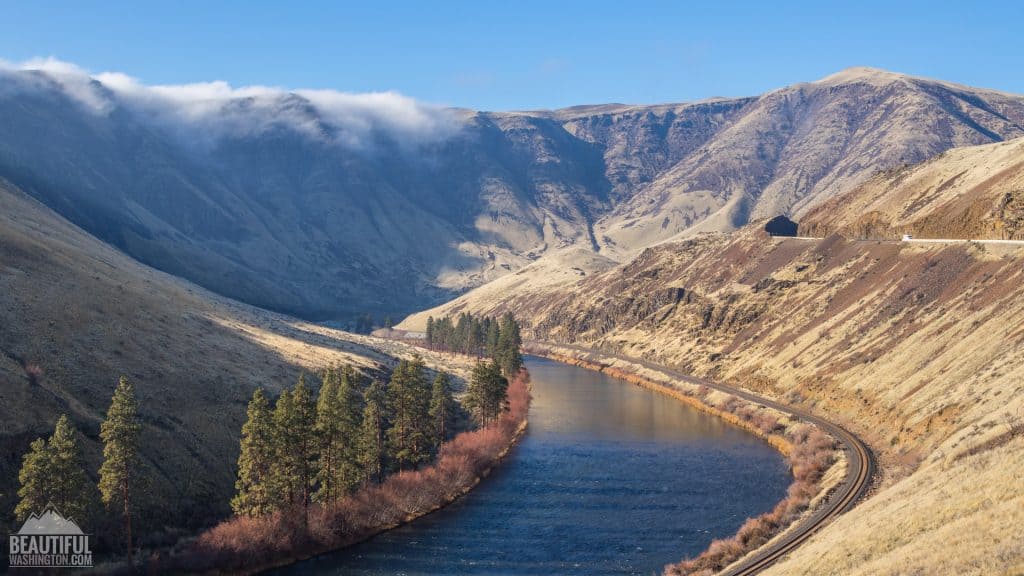
Route & Directions
- Follow State Route 821 from Ellensburg to Selah for a scenic 25-mile drive through the Yakima River Canyon. This drive follows the Yakima River, with towering basalt cliffs and sweeping views of the surrounding landscape.
Spring
- Description: Spring in the Yakima River Canyon is marked by blooming wildflowers and greenery. The river is full from snowmelt, making it an ideal time to visit for birdwatching and wildlife.
- Stops:
- Umtanum Creek Recreation Area: Take a hike along Umtanum Creek, a peaceful trail known for its spring wildflowers and chances to spot bighorn sheep.
- Yakima River: Great for spring fishing, especially for trout. Several pull-offs along the byway provide easy access to the river.
- Tip: Spring is also ideal for photography, with vibrant wildflowers contrasting against the basalt cliffs.
Summer
- Description: The Yakima River Canyon is a popular summer destination for floating down the river. Warm temperatures and long sunny days make it perfect for water-based activities.
- Stops:
- Floating the Yakima River: Rent a tube or raft in Ellensburg and enjoy a leisurely float down the cool river.
- Roza Recreation Area: A great spot for picnicking, swimming, or launching a boat.
- Tip: Bring plenty of sunscreen, water, and snacks for a day on the river. The canyon can get quite hot in the summer.
Fall
- Description: Fall transforms the canyon into a beautiful blend of gold and red hues, with crisp air perfect for hiking and photography. The Yakima River remains a good spot for fishing.
- Stops:
- Umtanum Ridge Crest Trail: Hike up this ridge for panoramic views of the canyon and fall colors.
- Fishing on the Yakima River: Fall is an excellent season for fly fishing, especially for trout.
- Tip: Early fall is best for hiking, as the temperatures are cooler, but not yet cold. Pack a warm jacket for later in the day.
Winter
- Description: Winter in the Yakima River Canyon is peaceful, with fewer visitors. The basalt cliffs and river create a striking landscape, especially when dusted with snow.
- Stops:
- Winter Wildlife Viewing: The canyon is home to bighorn sheep and bald eagles, making it a great spot for winter wildlife watching.
- Selah: Warm up in this small town after a day of exploring. Visit local cafes and shops for a relaxing end to your trip.
- Tip: Dress warmly and be prepared for icy roads in the canyon during winter months. The peaceful atmosphere makes it perfect for quiet, scenic drives.
Here are a couple more excellent scenic drives in South-Central Washington to consider:
Columbia River Gorge Scenic Byway
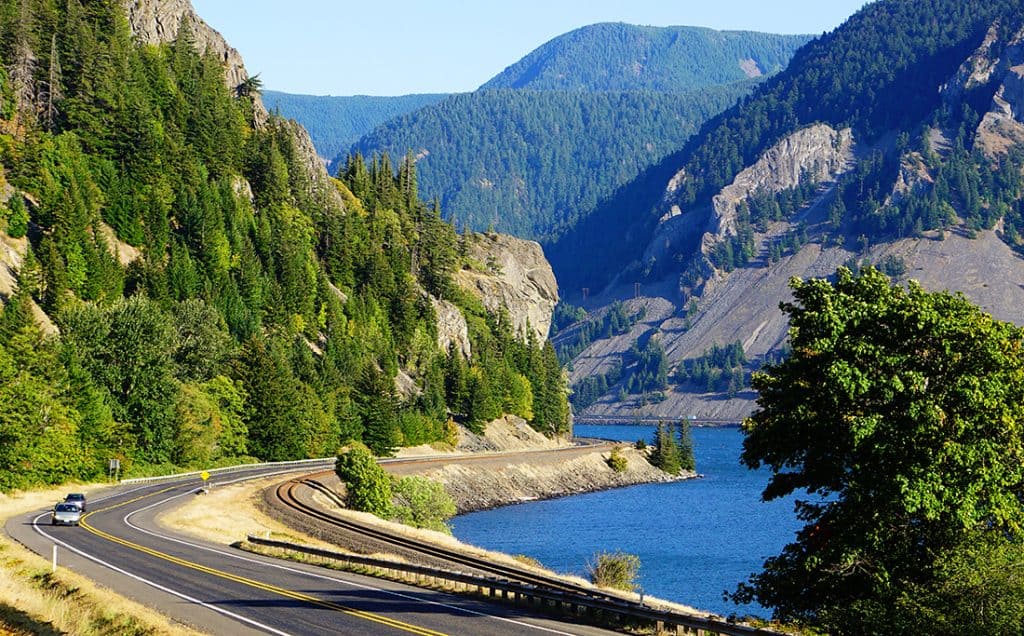
Route & Directions
- Starting in Maryhill or Goldendale, follow State Route 14 along the northern side of the Columbia River. This drive spans approximately 75 miles, offering breathtaking views of the river and cliffs, with access to wineries, hiking trails, and historic sites.
Spring
- Description: Spring brings green hillsides and blooming wildflowers along the river gorge. This is also the best time to visit waterfalls, which are flowing at their peak.
- Stops:
- Columbia Hills Historical State Park: Hike the Dalles Mountain Ranch Trail to see fields of wildflowers with stunning views of Mount Hood in the distance.
- Maryhill Museum of Art: A unique museum with art exhibits and historical collections. It’s a great stop for culture and history.
- Tip: Spring is perfect for wildflower hikes and photography. Pack a rain jacket as showers are still possible in early spring.
Summer
- Description: Summer is ideal for water sports on the Columbia River, including windsurfing, kayaking, and fishing. The dry, warm weather makes the area a great escape for outdoor recreation.
- Stops:
- Maryhill Winery: Stop for wine tasting with spectacular views of the Columbia River.
- Beacon Rock: A popular summer hiking spot, offering a climb up the rock for sweeping views of the river.
- Tip: Bring sunscreen and plenty of water, as temperatures can climb above 90°F. It’s also the best time for river activities, so plan ahead for equipment rentals.
Fall
- Description: The Columbia River Gorge is magical in fall, with vibrant leaves creating a patchwork of gold and red along the cliffs. The cooler temperatures are perfect for hiking and wine tasting.
- Stops:
- Rowena Crest Viewpoint: A stunning overlook offering expansive views of the river gorge, framed by fall foliage.
- Horsethief Lake State Park: Visit for fall hikes and a quieter atmosphere to enjoy the changing leaves.
- Tip: Early fall is best for warm days and cooler nights. Bring layers and a camera to capture the fall colors and views along the gorge.
Winter
- Description: Winter brings quiet roads and a peaceful atmosphere to the gorge. The cliffs and river create a stark but beautiful winter landscape, and it’s a great time to visit for a peaceful drive.
- Stops:
- Stonehenge Memorial: Visit the replica of Stonehenge near Maryhill for a unique stop with panoramic views of the Columbia River.
- Columbia Gorge Discovery Center: This museum offers exhibits on the natural and cultural history of the gorge, providing a warm, indoor stop during colder months.
- Tip: Be prepared for colder temperatures and windy conditions. Winter is a great time for birdwatching, as migratory birds can be spotted along the river.
Old Blewett Pass Scenic Byway
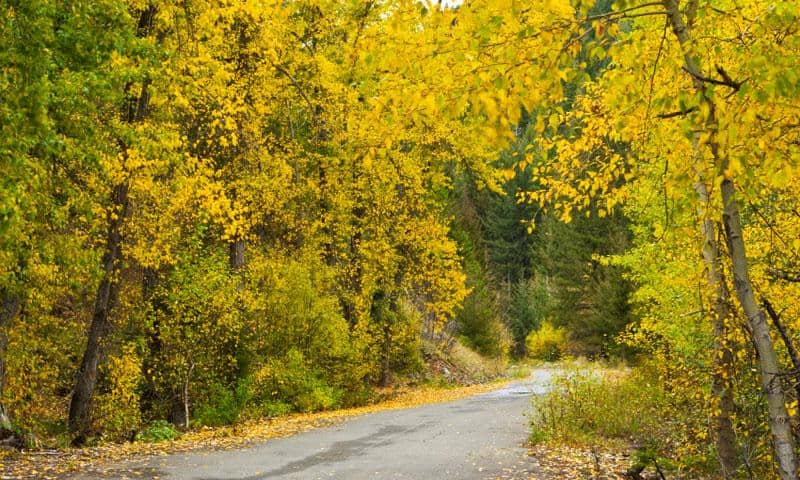
Route & Directions
- From Ellensburg, take US 97 north toward Blewett Pass. The old highway, Old Blewett Pass Road, can be accessed off US 97 and is a quieter, 13-mile detour through the mountains, offering a scenic backroad adventure.
Spring
- Description: Springtime brings wildflowers and fresh greenery along the mountain roads. As the snow melts, the creeks and rivers are running high, creating picturesque views around every bend.
- Stops:
- Old Blewett Pass: Explore the remains of historic mining towns and enjoy peaceful hikes along the old road.
- Swauk Creek: A perfect spot for picnicking, fishing, and enjoying the beauty of the creek surrounded by spring blooms.
- Tip: Early spring can still bring snow at higher elevations, so check road conditions before exploring the pass.
Summer
- Description: The old pass road is fully accessible in summer, offering solitude and scenic beauty as it winds through the Cascade Mountains. The area is perfect for hiking, camping, and wildlife viewing.
- Stops:
- Blewett Pass Rest Area: A great place to stop for scenic views and a picnic.
- Liberty Ghost Town: Visit the nearby historic town of Liberty, a former gold-mining hub, for a taste of Washington’s past.
- Tip: Bring plenty of water, as temperatures can rise in the summer months. The drive is popular among those seeking a quieter, off-the-beaten-path route.
Fall
- Description: Fall transforms Blewett Pass into a canvas of golden larches and bright autumn leaves. The crisp mountain air makes hiking and exploring the old pass especially enjoyable.
- Stops:
- Swauk Forest Discovery Trail: A beautiful fall hike with views of the changing foliage and educational signs about the area’s natural history.
- Teanaway Community Forest: Located nearby, it’s a perfect spot for fall hikes and photography.
- Tip: Early fall offers the best conditions, with mild weather and stunning fall colors. Dress in layers as temperatures can drop quickly.
Winter
- Description: Blewett Pass is a winter wonderland, offering snowshoeing and cross-country skiing along the old road. The pass remains quieter than other winter recreation areas, providing a serene snow-covered landscape.
- Stops:
- Old Blewett Road: Snowshoe or ski along the peaceful old road, surrounded by snow-covered trees.
- Liberty: Explore the old mining town, which takes on a magical quality when blanketed in snow.
- Tip: Be prepared for snow and icy roads. Carry chains or use a vehicle with four-wheel drive when exploring the area in winter.
Eastern Washington Scenic Drives
Palouse Scenic Byway
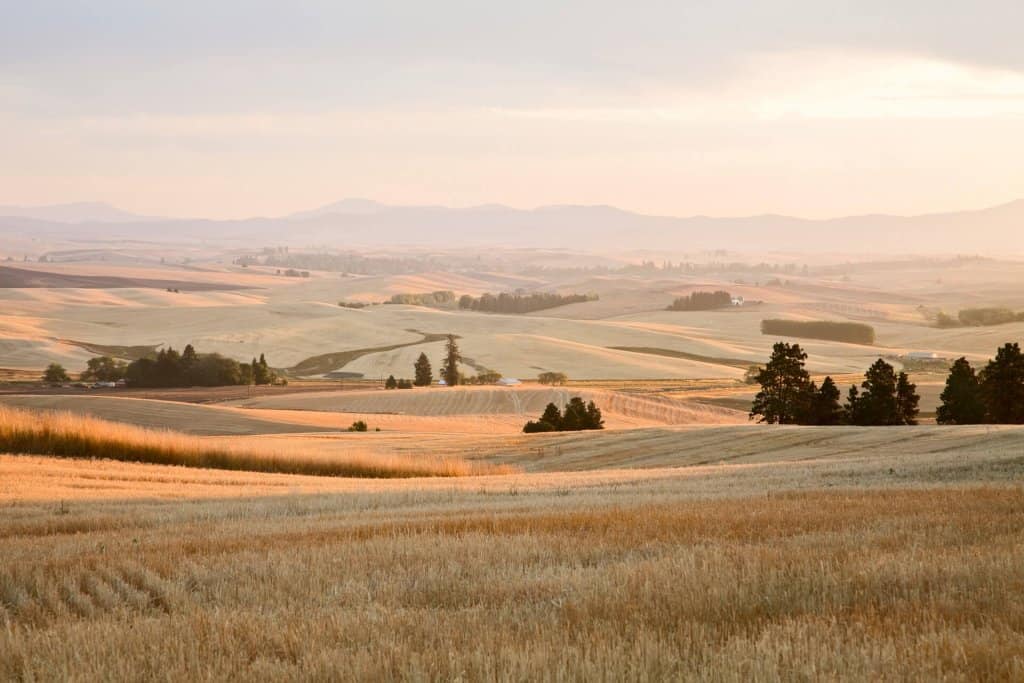
Route & Directions
- Start your drive in Colfax and follow the Palouse Scenic Byway, which loops through Pullman, Palouse, Uniontown, and other small farming towns. The drive covers approximately 208 miles of rolling wheat fields and small communities.
Spring
- Description: Spring in the Palouse is marked by vibrant green hills and fields of young wheat. The rolling landscape looks especially lush with the new growth of crops.
- Stops:
- Steptoe Butte State Park: Drive up Steptoe Butte for panoramic views of the Palouse’s rolling hills, which appear like a patchwork of green.
- Palouse Falls State Park: Spring snowmelt brings Palouse Falls to its most dramatic, with water cascading into the canyon below.
- Tip: Spring is ideal for photography, as the fields glow with the new growth of wheat and other crops.
Summer
- Description: Summer brings golden hues to the Palouse, with fields of wheat ready for harvest. The weather is warm and dry, making it a great time for exploring the small towns and backroads.
- Stops:
- Uniontown: Visit Artisans at the Dahmen Barn, a historic barn transformed into an art gallery, featuring local crafts and exhibits.
- Wawawai Canyon: A hidden gem with scenic views of the Snake River, perfect for a picnic or short hike.
- Tip: Bring plenty of water and sunscreen, as summer temperatures can soar. Sunrise and sunset offer the best light for photographing the golden fields.
Fall
- Description: Fall brings cooler temperatures and a peaceful atmosphere as the harvest season comes to an end. The fields take on earthy tones, and it’s a great time for leisurely drives.
- Stops:
- Palouse Town: Explore the small town of Palouse with its quaint downtown area and antique shops.
- Steptoe Canyon Road: A scenic detour offering views of the Snake River, especially beautiful in fall with changing colors along the riverbanks.
- Tip: Fall is great for quiet walks and scenic drives. Dress in layers, as the weather can be unpredictable.
Winter
- Description: Winter transforms the Palouse into a snowy wonderland. The rolling hills are dusted with snow, offering a peaceful and serene landscape.
- Stops:
- Steptoe Butte: The butte is also accessible in winter, providing a striking contrast of white snow over the dark hills.
- Pullman: Visit the Washington State University campus, which is especially beautiful during the winter months.
- Tip: Be prepared for cold and possibly icy conditions. Roads may be slick, so drive carefully and enjoy the peaceful scenery.
Coulee Corridor Scenic Byway
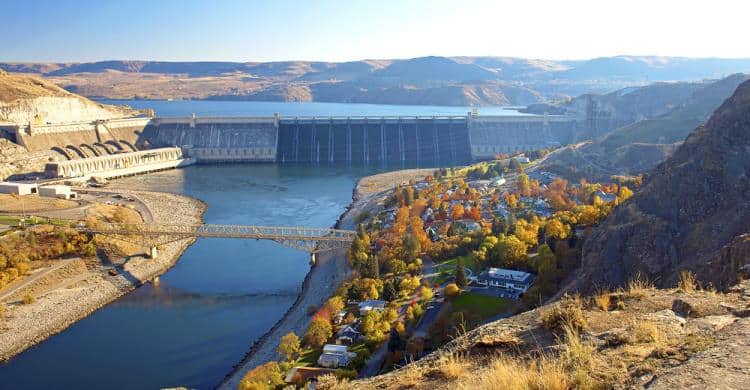
Route & Directions
- Begin your drive in Othello and follow State Route 17 north toward Grand Coulee, covering approximately 150 miles of dramatic desert landscapes, lakes, and unique geological formations.
Spring
- Description: Spring is the perfect time to explore the Coulee Corridor, as wildflowers bloom across the desert landscape, and lakes are full from snowmelt.
- Stops:
- Sun Lakes-Dry Falls State Park: View the remnants of a prehistoric waterfall larger than Niagara Falls and hike along the park’s scenic trails.
- Potholes Reservoir: A popular stop for fishing and birdwatching, with plenty of quiet spots to relax by the water.
- Tip: Spring brings cooler temperatures, making it ideal for hiking and exploring the unique geological features of the region.
Summer
- Description: Summer in the Coulee Corridor brings hot, dry weather, perfect for boating, swimming, and fishing in the region’s many lakes.
- Stops:
- Banks Lake: Enjoy swimming, boating, or camping along this large reservoir, surrounded by striking basalt cliffs.
- Grand Coulee Dam: Visit this massive dam, and don’t miss the evening laser light show during the summer months.
- Tip: Pack sunscreen and stay hydrated, as temperatures can reach over 90°F. Summer is the best time for water-based activities, so plan to spend time on the lakes.
Fall
- Description: Fall offers cooler temperatures and fewer crowds, making it a great time to hike and explore the area’s geological history. The landscape takes on earthy tones, creating a unique atmosphere.
- Stops:
- Steamboat Rock State Park: A perfect spot for hiking, with trails offering views of Banks Lake and the surrounding cliffs.
- Dry Falls Interpretive Center: Learn about the area’s unique geological history and how the landscape was shaped by the Ice Age floods.
- Tip: Early fall is best for warm days and cool evenings. Bring a jacket for early morning hikes, as temperatures can drop quickly.
Winter
- Description: The Coulee Corridor becomes quiet in winter, offering peaceful drives and opportunities to explore the area’s natural beauty without the crowds.
- Stops:
- Sun Lakes-Dry Falls State Park: Visit for a peaceful winter walk along the trails, with stunning views of the basalt cliffs dusted with snow.
- Winter Birdwatching: The region is home to migratory birds, making winter a great time for birdwatching, especially near the Columbia River.
- Tip: Dress warmly and be prepared for windy conditions. Roads may be icy, so drive carefully, especially in the canyon areas.
Sherman Pass Scenic Byway
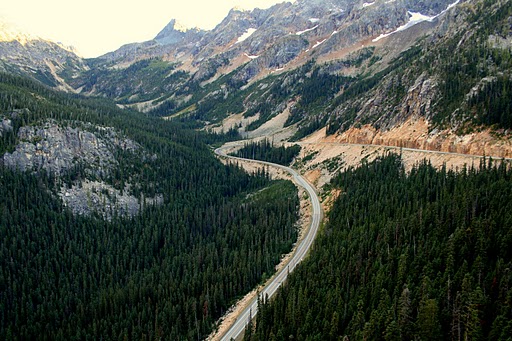
Route & Directions
- This drive begins in Republic and follows State Route 20 over Sherman Pass, the highest maintained pass in Washington State, before descending toward Kettle Falls. The byway stretches for 35 miles through Colville National Forest.
Spring
- Description: In spring, the forests surrounding Sherman Pass come alive with fresh greenery, and the waterfalls and creeks are flowing at their highest.
- Stops:
- Sherman Overlook: Enjoy panoramic views of the Kettle River Range and read about the area’s history on interpretive signs.
- Curlew Lake State Park: A great spot for fishing and boating, with peaceful views of the surrounding mountains.
- Tip: Spring rains can make some hiking trails muddy, so bring sturdy boots. The waterfalls are most impressive in early spring.
Summer
- Description: Summer offers ideal conditions for camping, hiking, and wildlife watching in the national forest. The warm weather makes for a pleasant drive over the pass.
- Stops:
- Sherman Pass Overlook: Stop to take in the panoramic views of the forest and mountains.
- Colville National Forest: Explore the forest’s hiking trails, or take a day to relax by one of the many lakes and rivers in the area.
- Tip: Summer is ideal for outdoor adventures, so pack a picnic and enjoy the many trails and recreation areas along the byway.
Fall
- Description: Fall brings golden larches and bright autumn colors to the byway. The cooler weather is perfect for hiking and exploring the scenic overlooks.
- Stops:
- White Mountain Overlook: Stop for a short hike to see views of the surrounding mountains, with golden larches dotting the landscape.
- Log Flume Heritage Site: Learn about the area’s logging history and take a walk along the interpretive trails.
- Tip: Dress warmly, as temperatures drop quickly at higher elevations. Early fall offers the best fall foliage views along the byway.
Winter
- Description: Winter transforms the byway into a snowy landscape, offering opportunities for snowshoeing and cross-country skiing in the surrounding national forest.
- Stops:
- Sherman Overlook: Even in winter, the overlook offers stunning views of the snow-covered mountains.
- Colville National Forest: Bring your snowshoes and explore the quiet trails through the snow-covered trees.
- Tip: Check road conditions before heading out, as snow and ice can make driving challenging. Be prepared with chains or a four-wheel-drive vehicle.
Blue Mountain Scenic Byway
Route & Directions
- Begin in Dayton and take State Route 129 south through Pomeroy, continuing along Forest Road 64 through the Umatilla National Forest and the Blue Mountains. This 95-mile drive takes you through high desert landscapes and dense forests.
Spring
- Description: Spring is a great time to explore the Blue Mountains as wildflowers bloom, and the landscape begins to green up after the winter months.
- Stops:
- Tucannon River: Stop at the Tucannon River for fishing, hiking, or camping along its banks.
- Umatilla National Forest: Explore the lower-elevation trails in the national forest, which are dotted with wildflowers in the spring.
- Tip: Spring rains can make the trails muddy, so bring sturdy footwear and rain gear for hikes.
Summer
- Description: Summer offers warm days and cool nights in the Blue Mountains, making it a perfect time for camping, hiking, and wildlife viewing.
- Stops:
- Jubilee Lake: A peaceful alpine lake where you can hike, fish, or picnic in the shade of towering pines.
- Bluewood Ski Resort: Even in summer, Bluewood offers scenic chairlift rides and great views of the surrounding mountains.
- Tip: Bring plenty of water and sunscreen, as summer temperatures can be warm in the lower elevations.
Fall
- Description: Fall in the Blue Mountains brings vibrant autumn colors, especially in the Umatilla National Forest, where the aspen and larch trees turn golden.
- Stops:
- Umatilla National Forest: Drive through the forest and stop for short hikes among the colorful fall foliage.
- Lewis and Clark Trail State Park: Explore the riverside trails in this peaceful park, located near Dayton.
- Tip: Early fall is the best time to visit, as cooler weather makes hiking and exploring more comfortable. Pack layers for cooler temperatures at higher elevations.
Winter
- Description: Winter transforms the Blue Mountains into a snowy playground, with opportunities for snowshoeing, cross-country skiing, and snowmobiling.
- Stops:
- Sno-Parks: There are several sno-parks in the Umatilla National Forest where you can snowshoe, ski, or snowmobile in the peaceful winter landscape.
- Bluewood Ski Resort: Hit the slopes at Bluewood, known for its light powder and family-friendly atmosphere.
- Tip: Be prepared for snowy and icy conditions, especially at higher elevations. Carry chains or drive a four-wheel-drive vehicle when traveling through the mountains in winter.
Content creator and writer for multiple websites including All About Glamping, Fit Living Lifestyle, and Live Dream Discover. A full-time traveler who has spoken at various travel conferences around the world.

